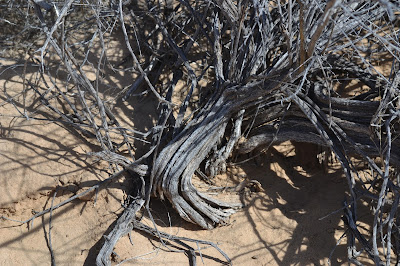The short version of the story: 200,000 years ago volcanos spewed basaltic lava from a 5 mile long crack in the crust of the earth. Time and erosion exposed tons of basalt boulders.
The Native Indian people left their mark on the stones, carving petroglyphs into the hard black rock to reveal the lighter color underneath, leaving behind depictions of the people and their life, the desert, its animals and birds, as well as geometric designs.
There are over 24,000 images here at The Petroglyph National Monument. Managed by the National Park Service, it is protected and revered as a sacred site; the boulders are just out of reach from curious hands and the penalties for defacing any part of the area include fines and imprisonment. This is bullet damage from before the site was protected as it is now.
Thankfully, the Park is now safe from vandalism.
Some of these works are proven to be between 2,000 - 3,000 years old. Others are believed to be 400 - 700 years old.
This spiraling circle represents the circle of life.
This is a silent place, a sacred place. We stood and thought about the people who lived and traveled through The Rio Grande Valley. Their petroglyphs have survived thousands of years of weather, allowing us to stand here today and admire their work, to stand in their footprints.
They walked here, they stood here, they lived here.
Do you hear the silence?
The images range in size
from a handspan to over a square foot in size.
The artists used the natural formation
of the rocks to exhibit their work:
I know, you're secretly thinking, Dear Gawd, I hope she didn't take a photo of all 24,000. You're welcome.
The Thunderbird:
Being in the desert is like slipping into a fuzzy warm pair of footie pajamas. I loved feeling the sun warm my bones. And the quiet.
(No, these aren't my bones).
The Spanish introduced sheep, horses and other livestock;
they too carved into the black rock in their own unique style:
They also introduced and celebrated their religion:
Zuma was very happy to walk the 2.2 mile round trip through Riconada Canyon. The site covers the 17 mile escarpment with petroglyphs in three canyons.
Zuma The Desert Dawg:
She was fascinated by all the scents and tracks.
We didn't spot any live animals other than a few small birds perched on dried grasses and hawks soaring overhead, but there was evidence a-plenty of desert hares and other slithery critters who left their wavy trails in the sand. There are Roadrunners here but none crossed our path, only their light tracks. I'm just really freaking glad we didn't stumble upon a Rattlesnake. I'm still not over that snake museum.
Even in this barren desert landscape,
there are many signs of life, both past and present.
"Take time to look .... " ~ Georgia O'Keeffe.
#rinconadacanyon, ##Petroglyphnationalmonument, #alberquerque, #desertnewmexico, #petroglyphs, #riograndevalley, #nationalparkservice, #travelingwithgreatdanedog































No comments:
Post a Comment